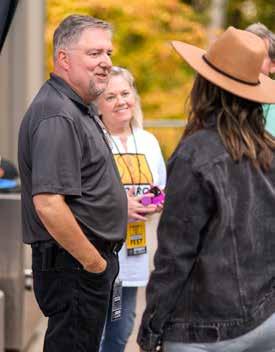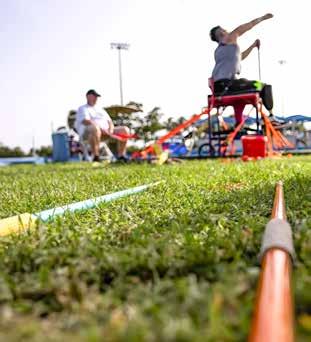









By Shirley Bloomfield, CEO NTCA–The Rural Broadband Association
When we’re connected, America thrives, and for rural communities, the federal Universal Service Fund (USF) helps community-based providers deliver broadband built to last for generations. This fund is critical for ensuring highquality, affordable broadband services are available for families, schools, libraries, health care facilities and so much more.
The idea behind the USF is that all Americans should have reliable access to communications services at a reasonable cost—it’s been a national objective for over a century and was codified into law in the 1996 Telecommunications Act. Today, the USF enables providers to make a business case to invest in many rural areas, sustain networks once they are built and keep service rates affordable.
Unfortunately, the USF is at risk of disruption. Last summer, a federal circuit court declared that the way the USF is funded is unconstitutional, and the case is now before the Supreme Court for review.
According to an August 2024 survey of more than 200 NTCA members across 35 states, the loss of USF support could be catastrophic for rural consumers. Respondents reported that rural consumers could see their monthly bills increase by $72. And 68% of respondents said they may need to cancel over $1 billion in deployment projects.
These survey results highlight the importance of the USF in both getting and keeping rural consumers connected to high-quality, affordable services. You can learn more at ntca.org/universalservice.
The online world moves fast, and it’s a rich, helpful place. In fact, there are so many opportunities and so many resources that keeping up with the latest can prove daunting. Here are a few hot topics:
These bite-sized videos usually last a few seconds. They’re often lighter in tone. Many are great for showing fun or helpful ideas quickly, such as cooking tips, telling a joke or sharing engaging facts. Others are simply silly fun. Most social media services offer some version of these videos.
AI is appearing in more and more places. It may help complete a text message, edit and sort photos on a smartphone or even create an image from scratch. And that’s only the beginning. Think of AI as a smart, learning system capable of processing tremendous amounts of information—and it’s changing and growing daily.
This digital currency is stored and managed on secure systems. Bitcoin is a famous example, but there are many others. Some people use cryptocurrency to buy goods or services, and others consider it an investment. It’s another growing, diversifying part of the digital world.
With the right hardware, such as VR goggles, virtual reality can be like stepping into a video game or movie. It’s also a rapidly growing technology, expected to become more affordable and accessible over time.
The arrival of streaming entertainment services brought the promise of simple, affordable access to deep, rich libraries of content. So, how are these increasingly popular
With so many possibilities, first consider what you generally want to watch. Do you love original dramas? Perhaps classic sitcoms and movies are your favorites? Are live sports or kids’ programming your go-to shows? Or maybe it’s a mix of all of the above. Here are a few options:
For exclusive originals: Netflix, Hulu and Max—formerly HBO Max—are standouts. They mix fresh shows and movies with a wealth of older favorites. And Hulu gives access to TV episodes the day after they air on traditional TV.
For family and classics: Disney+ shines. And Peacock and Paramount+ serve up plenty of longtime favorites, as well as new shows.
services, ranging from Netflix to YouTube TV, doing? Seemingly endless content? Check. Simple and affordable? Well, that gets a little complicated.
With care, though, you can find the
When it comes to pricing, streaming services increasingly offer a range of options—along with some tradeoffs. Many services have lower-cost plans, but they come with ads. If you don’t want interruptions, be prepared to pay extra. Similarly, Netflix offers a more expensive choice for high-definition content. Meanwhile Disney+ emphasizes the ability to bundle added services like Hulu.
Netflix: A lower-priced ad tier was introduced in 2023 to go along with the more expensive ad-free option.
Disney+ and Hulu: The price difference between ad-supported and ad-free versions is significant, so be aware when considering such services.
Amazon: Members of Amazon Prime must now pay an extra fee to remove ads from streaming content.
So, the price considerations of comparing streaming services to traditional cable television is more complex. But the system offers consumers greater choice—after all, many people don’t mind ads. Pricing and offers can change quickly, so check each service for the current rates and offers.
services that not only meet your needs but also your budget. Live sports, ad-free options, high-definition streams and so much more are a few clicks away.

Traditional TV networks are still the biggest player in the live sports world, but services like YouTube TV and Sling allow you to tap into many of those channels. However, the streamers are catching up.
Services like ESPN+, Peacock and Paramount+ have exclusive sports content. Amazon Prime hosts NFL games on Thursday nights. Even Netflix recently showcased a live night of boxing.
Then, there are also the direct-toconsumer options, like the NFL’s Sunday Ticket or MLS Season Pass on Apple TV. Fans can binge-watch their favorite leagues.
Even though it doesn’t always feel like it, spring is replacing winter, and I can’t wait. It’s time to get outside for fun and maybe a little bit of work, too. This is the time of year when many of us plan to spruce up the yard, plant a garden or tackle overdue home chores.

JOHNNY MCCLANAHAN President/CEO
Whatever task you need to get done or hobby you enjoy, there are likely internet-based resources that can help. At NCTC, we see firsthand examples of how access to high-speed broadband empowers you to learn, plan and confidently execute projects.
Consider gardeners, for example. It doesn’t matter if someone is a beginner or a seasoned green thumb, they can use the internet to research plant varieties suited to their climate, find layout ideas for vegetable gardens and even order seeds and supplies online. YouTube tutorials provide step-by-step guides for building trellises, creating compost bins and improving soil quality. Websites like the Farmers’ Almanac and our fantastic state extension offices are also great resources that can provide planting calendars and pest management tips.
Even better, online communities let gardeners share advice and troubleshoot problems in real time. From identifying mysterious weeds to diagnosing yellowing leaves, having access to expert advice—or a crowd of helpful fellow gardeners—can make all the difference.
Or perhaps you struggle with keeping a lush, green lawn. Those never happen by accident. Fortunately, you don’t need to be a landscaping expert to achieve one. Go online to find lawn care schedules tailored to your region and learn about the right fertilizers, grass seed mixes and weed treatments. Online video tutorials show how to aerate your soil, reseed patchy areas and properly mow for healthy growth.
Tech-savvy homeowners can even use smart irrigation systems connected to Wi-Fi to control watering systems from a smartphone. These tools improve water usage and keep your lawn looking great, even during hot, dry spells.
There are plenty of other ways modern digital tools can make life a little easier. From fixing leaky faucets to repairing drywall, the internet has become a go-to resource for home repair solutions. With access to instructional videos, product reviews and downloadable manuals, you can tackle many common repairs.
While the internet can help you dream big about your spring projects, it’s important to make safety a priority—especially if your plans involve digging. Before you break ground for a new garden bed, fence or deck, call 811 to have underground utilities marked. It’s free. It’s easy. And it could save you from costly repairs—or worse, a dangerous accident.
Broadband internet has made it easier than ever to plan and execute DIY projects, but some tasks still require a little extra preparation. As you gear up for a productive spring, let the web be your guide—but don’t forget to make that crucial call before you dig.
Here at NCTC, we’re proud to keep our community connected and equipped for success, whether you’re planting tomatoes or building a new patio. Happy spring—and safe digging!
The North Central Connection is a bimonthly newsletter published by NCTC, © 2025. It is distributed without charge to all member/ owners of the cooperative.


North Central is a member-owned corporation dedicated to delivering advanced telecommunications technology to the people of Northern Middle Tennessee and Southern Kentucky, including Macon County, Tennessee, Allen County and Warren County, Kentucky. NCTC also serves portions of Sumner, Trousdale, Smith and Clay counties in Tennessee.
North Central
872 Highway 52 Bypass E P.O. Box 70 Lafayette, TN 37083 Telephone: 615-666-2151 www.nctc.com
Glen Hardcastle
Chairman of the Board
Scottsville Exchange West
Randy Harston
Vice Chairman of the Board
Scottsville Exchange East
Calvin Graves
Secretary of the Board
Bethpage/Oak Grove Exchanges
Martha Bowser
Westmoreland Exchange
Kevin Dickerson
Defeated/Pleasant Shade Exchanges
Donnie Steen
Lafayette Exchange East
Jeff Flippin
Lafayette Exchange West
Chad Evitts
Hillsdale/Green Grove Exchanges
Chad Owens
Red Boiling Springs Exchange
Johnny McClanahan
President/CEO
Guy Holliman
General Counsel
Produced for North Central by:
On the Cover:

Designed and built by Caudill Construction and Design, this home swept the awards during the BASCKY 2024 Parade of Homes.
See story Page 12.
NCTC is celebrating its 75th anniversary by commemorating your historic photos in our 2026 calendar. We’re looking for interesting photos of people and places over the years since NCTC strung the area’s first telephone wire in 1951. Maybe you have a photo of an old schoolhouse in 1953, or a photo from a local landmark taken in 1975? You get the picture.
Here are a few guidelines:
• All photos must be of local locations.
• If the photos are from a time before the digital age–and many will be–please take a high-resolution, landscape, or horizontal, picture of the photo. You can do it with your phone or a digital camera. All photos should be sent via email to amy.phelps@nctcstaff.com in the largest size available. In the email, make sure to tell us who and/or what is in the photo and when it was taken.
• The deadline for submission is July 31. Be sure to include your name, phone number and address with your submission.


The NCTC Board of Directors and staff wish you a joyful Easter. Our business offices will be closed for Good Friday on April 18. As always, our help desk is available 24/7/365 at 270-622-2056.


Here are a few tips for dealing with dreaded robocalls:
• Add your number to the National Do Not Call Registry.
• Let calls from unknown numbers go to voicemail.
• If you accidentally answer a robocall, just hang up. Pushing other numbers or answering yes can cause an unauthorized charge.
• If the caller asks for anything involving a gift card, it’s very likely a scam.
• Report any scam calls to the FCC Consumer Complaint Center.

Story by KATHY DENES
It’s a rite of passage—a child in the roller coaster line steps up to the mark, stands up straight and finally hits that magical measurement, tall enough to be welcomed aboard for a lifetime of adventure.
The thrill of roller coasters never grows old, whether they’re modern rockets of cold, sleek steel or creaky, wooden rides that are a nostalgic nod to yesteryear. Around 1,000 coasters in the United States and thousands worldwide offer limitless options for destination vacations.
“At this point, I’ve been on just under 1,200 unique coasters at over 300 different amusement parks,” says James Nocito, a CoasterNerds contributing writer whose hobby of “chasing down rides” has taken him to 38 countries on four continents.
“Sometimes, I do actually think the hobby is ridiculous, but it’s also given me a chance to visit all sorts of places I probably wouldn’t have otherwise, like all 50 U.S. states. I guess I’ve always compared it to people who try to see a baseball game at every Major League Baseball stadium or such.”
• For a selection of the country’s top 100 coasters, consult coasterbuzz.com/rollercoasters/top100.
• If taking younger travelers along, be sure to check height requirements for the coasters you hope to experience.
• To check real-time waits before you go, visit queue-times.com.
• Concerned about motion sickness? Snack on something fairly bland 30 minutes to an hour before jumping in line.
Roller coaster fans seeking out the fastest ride, wildest twists and turns or just a new experience have created a community. Numerous websites, like coaster101.com, and social media pages, like Facebook’s CoasterNerds, are dedicated to informing and connecting enthusiasts.
“There’s this whole community within the parks and coasters fandom, and some of the best people I met from internet chatrooms or online message boards when I was a teenager are people I know 20-plus years later, now hanging out in person,” James says.
He hesitates to cite one roller coaster as his favorite, “but if I were going to suggest to someone some of the biggest, baddest or craziest rides in the U.S., I’d probably start with Fury 325.” That ride at Carowinds in Charlotte, North Carolina, is North America’s tallest, fastest and longest giga coaster—one with a height or drop of at least 300 feet.


Consider visiting these thrill rides:
The Beast broke all records when it opened at Kings Island in Mason, Ohio, in 1979, and it still reigns as Guinness World Records’ longest wooden roller coaster.
The Voyage at Holiday World in Santa Claus, Indiana, is the world’s second-longest wooden coaster, running for 1.2 miles and featuring a world-record five underground tunnels.
It’s always coaster weather at the Mall of America in Bloomington, Minnesota, where the 7-acre center court offers five unique options.
Two record-breaking coasters—the nation’s first tilt coaster, the Circuit Breaker, and Palindrome, a one-of-a-kind infinity coaster—are set to open in Texas this year at Austin’s COTALand.
Also opening this year at Cedar Point in Sandusky, Ohio, is the Siren’s Curse, expected to break records for height, speed and longest tilt.



Look for CoasterNerds on Facebook and visit these websites for more information: coasterforce.com, aceonline.org, coaster101.com and coasterbuzz.com.

Around
the time John Buchanon was growing up in Scottsville, the Lyric Theater housed a discount store. But his mother’s generation knew the 1930s-era building as the town’s movie theater.
When Buchanon got involved with the Allen County-Scottsville Arts Council a few years ago, he liked the idea of the majestic old theater building returning to its roots as a home for the arts. “So, we negotiated rent for it, and now we’ve turned it into a music venue slash art exhibit hall—it’s a multipurpose facility,” he says.
Today, the arts council produces Live at the Lyric, a monthly show featuring musical acts of all genres, including bluegrass, blues, country, jazz and gospel.
But it’s far from the arts council’s only accomplishment. The 40-year-old nonprofit has long been enriching the
Story by JEN CALHOUN
Someone You Love,” which reached No.
NorroFest, which will celebrate its fifth year in October, is a full-on music festival. Buchanon, a Scottsville native, is the CEO and president of Bigscreen LLC, a Nashville-based company that helps produce and stream various events including national awards shows.
arts events and various artistic outlets for children, including a children’s choir, an annual creative writing contest, the Summer Soundz concert series and its annual Arts Day Camp at the Core.
One of the group’s most popular events is NorroFest, an annual music festival that takes place in the fall at Dugas Park. Buchanon says the event was inspired by the late Norro Wilson, a Scottsville native and member of the Nashville Songwriters Hall of Fame, who wrote the song “The Grand Tour” for George Jones.
He also wrote or co-wrote songs for other country singers, including Tammy Wynette, Charlie Rich and Charley Pride. In addition, he produced or co-produced songs for Reba McEntire, Kenny Chesney and Shania Twain. Before that, Wilson was a singer with three Top 40 country hits of his own, including “Do It to
Dugas Park’s amphitheater is a hidden gem and the perfect venue for concerts and festivals, Buchanon says. He likens it to Nashville’s Ascend Amphitheater, which hosts large outdoor events like the CMA Music Festival.
“With NorroFest, we do full concert lighting and sound, food trucks and even adult beverages,” he says. “It’s a professional concert, and we hope we can make it a multiday event at some point.”
NorroFest is the beginning part of a plan to make Scottsville a musical destination.
“Scottsville’s in a renaissance period, and I truly believe that,” Buchanon says. “When I was growing up here, I knew I would have to leave town. I had to go to Nashville to have a career. But now, the world has gotten so much smaller. You don’t have to move anymore because of fiber internet. People can work from anywhere. So, our thing is, why not Scottsville?”

Buchanon returned to Scottsville in 2019, after living and working in Nashville for more than 30 years. “I was able to do that because of NCTC’s fiber business class internet,” he says. “Concerts are a big part of my career, and during COVID-19, I was doing all these concerts with no one in the crowd.
“The first one I did was Garth Brooks, and he staged this whole concert with no one there. They filmed it, and we edited it. He sold it to drive-in theaters during the pandemic.”
His company, Bigscreen, has also done editing and other work on the CMA Music Festival for several years. “I worked on that right here in Scottsville using NCTC’s fiber,” he says.
One of the first things Buchanon did when he joined the arts council was tape a community concert for Christmas in 2020. “Everything was shut down, but we were able to film a concert that we called ‘A Very Socially Distanced Christmas.’ We put it up on YouTube and Facebook, and I think about 4,000 people saw it.”
The number of viewers astounded the council. Usually only a fraction of that audience would get to see the group’s events. “Now, people from all over the country who have a connection with Scottsville and Allen County can watch these things,” Buchanon says.


ABOVE: Musicians play at a recent NorroFest. The festival was named in honor of the late Norro Wilson, a Scottsville native and member of the Nashville Songwriter’s Hall of Fame.
TOP LEFT: Dugas Park’s amphitheater and stage set the scene for NorroFest.
TOP RIGHT: John Buchanon, executive director of the Allen County-Scottsville Arts Council, is the president and CEO of Bigscreen. The company produces and streams various events, including the CMA Music Festival.
OPPOSITE PAGE: A band plays at the amphi-theater in Dugas Park during NorroFest, the arts council’s annual fall music festival.
To find out more about the Allen County-Scottsville Arts Council, its events, its scholarships and much more, visit the website at acsarts.org or like the group’s Facebook page. Check out past concerts and events on the group’s YouTube channel.
For more information on NorroFest, the council’s annual music festival in Dugas Park, visit norrofest.com. The site offers a lineup of acts, information on the festival itself and a link to buy tickets.
Story by DREW WOOLLEY and JEN CALHOUN


After Shane Farver’s lower-level spinal cord injury, the rockclimbing enthusiast realized he needed to learn new ways of moving through the world, whether scrambling up rocks or making his way through shopping malls and office buildings.
“Early on in my recovery, a friend of mine said, ‘A cool thing about climbing is the problem-solving aspect of it. You have to figure out how to get from this hold to that hold as efficiently as possible using your body as it is and kind of figuring those things out,’” Shane says.
It’s the same for people with disabilities, he says. “We have to be problem-solvers, because—very often—the world is not made for us.”
Today, Shane is communications director and a member of the organizing committee for the Adaptive Climbers Festival. The three-day event offers people with disabilities a chance to learn rock climbing and other outdoor skills while camping and communing in Eastern Kentucky’s Red River Gorge.
“We really emphasize the notion that we do not take people with disabilities rock climbing,” Shane says. “We teach people with disabilities how to rock climb. The nuance there is we’re not here to take you on a ride. We’re here to empower you and help you see what’s possible in rock climbing and hopefully provide some confidence elsewhere in your life.”
The idea for the Adaptive Climbers Festival came about during a hot tub hang with a few adaptive climbers and their allies. “They were talking about the fact that outside of the competitive environment, there aren’t a lot of opportunities for people with disabilities to rock climb,” Shane says.

The first Adaptive Climbers Festival was in 2018 at a climbing area in northwest Alabama, but by 2022 the event found its home at Lago Linda Hideaway, a 410-acre wonderland that offers cabins, RV sites and campgrounds surrounding a 5-acre lake.
“We have our run of the place,” Shane says. “Once we figured out that setup, we didn’t want to hold it anywhere else. We also have other partners who help us out, including the local search and rescue folks. It’s a huge coordinated effort.”
The event offers about 30 clinics, including courses on rappelling and anchor-building, which shows attendees how to set up their ropes for climbing. Most of the courses are led by people with disabilities.
“That’s kind of our ethos—the idea that we’re here to empower people and to give people opportunities to grow and lead,” Shane says.
The Adaptive Climbers Festival has grown from about 30 participants to about 150 in 2024, including attendees from across the country, as well as some from Australia, New Zealand, Canada and Spain.

The first time Beth King saw a recumbent tricycle, she thought it was a joke. She rarely left the house for anything other than doctors’ appointments after retiring from the military in 2014 due to injuries she sustained three years earlier when a rocket-propelled grenade brought down her Chinook helicopter in Afghanistan.
Then, after battling a traumatic brain injury, rehabbing for permanent damage to her spine and back and undergoing a bilateral joint replacement for severe pain in her jaw, Beth’s occupational therapist wanted her to hop on what to her looked like a child’s toy.
“When she showed me a picture, it looked like a Big Wheel from when I was a kid,” says Beth, who was not happy about the idea. “But halfway through my first ride, I realized I’m out here by myself, no one’s running after me to catch me. And I really found that


ABOVE: Training to succeed in new sports, like javelin, cycling, powerlifting and rowing, gives Beth King the confidence to overcome life's other challenges.
OPPOSITE PAGE: Participants in the Adaptive Climbers Festival come from all over the world to enjoy a weekend of rock climbing, fellowship and fun in Eastern Kentucky's Red River Gorge area.
liberating. I felt a sense of independence I hadn’t felt in years.”
She then took part in the Wounded Warrior Project’s Soldier Ride, introducing her to the world of adaptive sports. Now based in Missouri, Beth has trained in javelin, rowing, discus and powerlifting, even competing at the 2022 Invictus Games in the Netherlands. She hopes to qualify for the Paralympics in 2028.
“It’s what saved me. I was really struggling with depression, suicidal thoughts and isolation. I just couldn’t deal with anything. And it gave me something to train for, to get out of bed for,” Beth says. “Sports made me realize that I could still do all the things that I thought I lost.”
Realizing she was losing almost all function in her feet, in 2023 Beth decided to have her right foot amputated, allowing her to begin learning to walk with an artificial one. Last year, she completed her first year of welding school, a goal she set after retiring from the military.
“I think sports really gave me the confidence to advocate for myself. To believe that I didn’t really lose as much as I thought I had,” she says. “If you had asked me a year ago if I’d be welding right now, I would have said, ‘No way.’ I couldn't see a life bigger than the box I had put myself in with my injuries.”
Once she finishes school, Beth hopes to be able to make adaptive equipment for more people. “I don’t think people always understand that it’s not just sports equipment. It’s freedom,” she says. “It’s a regular life and feeling like you’re a part of things. To have a place where people can go and just have fun and play a sport, even if it might look different. I think people are starting to realize that it really does matter.”

Story by JEN CALHOUN
Over the last few years, Tony Swift has seen a steady uptick in the number of out-of-towners buying homes built by Red Ladder Construction, his Bowling Green-based company. Whether the draw is the small-town atmosphere or the relatively inexpensive cost of living, he’s not entirely sure. What is clear, however, is that the trend shows no signs of slowing.
“The last five houses I’ve sold have been to people from out of state,” says Tony, who also owns Mr. Rooter Plumbing of Bowling Green. “They’ve been from Colorado and California. Then there was one from Knoxville. Also, there are people who work in Nashville and come here to live. A couple of the people bought homes before they even saw them in person.”
To find out more about the Builders Association of South Central Kentucky and to access the resources it offers for anyone buying, building or remodeling a home, visit bascky. com. The 2025 board of directors’ officers are: President Tony Swift; 1st Vice President Barrett Hammer; 2nd Vice President Colby Henon; Secretary/Treasurer Jeff Peeples; Past President Cody Poston and CEO Anita Napier.
It’s an exciting time for builders like Tony, and it brings a boost to the region and its economy. But boom times can also create openings for scam artists and grifters posing as reputable contractors. That’s why it’s more important than ever to hire quality builders and contractors, says Tony, the newest president of the Builders Association of South Central Kentucky.
The association represents about 375 companies in the building industry in Warren, Allen, Barren, Edmonson and Simpson counties. This can include anyone from builders and contractors to electricians, designers and bankers.
One of the organization’s official acts is to register builders and remodelers based on several rigorous experience- and ethics-based requirements. The registry, available for free on the association’s website, offers a search function that lets users narrow down contractors by categories. Categories include residential builders, commercial and industrial builders, remodelers and fire restoration companies and developers. Not only are these registered members reputable and experienced, but they’re also required to commit to a code of ethics.
“Unfortunately, in construction, there are some bad people out there,” Tony says. “But if you choose someone from the builders
In 2021, the National Association of Home Builders’ American Housing Survey found that:
7% 40% 41 33 of homebuyers purchased a new home. were purchasing their first home. was the median age of all homebuyers. was the median age of first-time buyers.
Kevin Park, an economist with Economic & Strategic Research Group, outlined some of the reasons behind the increasing demand for homes in rural areas in a November 2024 blog post he wrote for Fannie Mae’s website.
“The confluence of increased demand for space, opportunities to work remotely and historically low interest rates during the COVID-19 pandemic had a substantial effect on the geography of housing demand,” he wrote. He cited these key trends:
The construction of 100 single-family homes creates more than 300 full-time jobs and generates $8.9 million in federal, state and local tax revenues.
Source: National Association of Home Builders
association to work for you, then you know they’ve already been checked out. They’re not going to scam you or take your deposit and disappear.”
In addition, BASCKY offers a listing for companies that provide all the services important to home building and renovating, including designers, decorators, carpenters, architects, painters and utility workers. The list also includes accountants, real estate agents, lawyers, insurance and title services and more.
The association is good for its members, too, Tony says. For one thing, members can easily connect with one another to form reliable networks of service providers. They also have access to hundreds of years’ worth of experience.
“If there are people who’ve been in the workforce for a while and want to go out on their own, they can become a member and get vetted by the association,” Tony says. “As long as they maintain the standards, it can only benefit them. It gives them a network of people to fall back on.”
The organization, affiliated with the Home Builders Association of Kentucky and the National Association of Home Builders, offers various training opportunities and continuing education for people in the industry. It also works with state, local and national governments on housing codes.
“From a builder’s standpoint, it helps our group make sure we’re maintaining codes that are important to us as a community, so we can put a quality product out,” Tony says.
Mortgage applications in rural communities surged during the pandemic and remain above prepandemic averages, despite the relatively high-interest-rate environment slowing demand in more urban areas.
Homebuyers from outside the region are driving the rise in rural housing demand—with second home and investment purchasers making up a large share early in the pandemic, followed by buyers planning to move in from outside the region.
Demand has increased across all types of rural communities, with resort communities seeing early spikes that have since tapered and institution-rich hubs seeing sustained demand.
Source: fanniemae.com
The Builders Association of South Central Kentucky hosts its annual Home Expo Feb. 28-March 2.
The association’s 2025 Parade of Homes will be Sept. 18-21.
For hours, locations and additional information on these events, visit the Builders Association website at bascky.com.

Italian cuisine, with its fresh ingredients and age-old techniques, has woven itself into the fabric of American culture.
Pizza, spaghetti and Alfredo are all favorites, but lasagna may top the list. It’s simply hard to resist. Keep the Italian theme going with an Italian chopped salad and a cannoli poke cake. Loosen your belt and get ready to embark on your Italian culinary experience without leaving home.

Food Editor Anne P. Braly is a native of Chattanooga, Tennessee.
Photography by Mark Gilliland
1 pound sweet Italian sausage
3/4 pound lean ground beef
1/2 cup minced onion
2 cloves garlic, crushed
1 (28-ounce) can crushed tomatoes
2 (6.5-ounce) cans tomato sauce
2 (6-ounce) cans tomato paste
1/2 cup water
2 tablespoons white sugar
4 tablespoons chopped fresh parsley, divided
1 1/2 teaspoons dried basil leaves
1 1/2 teaspoons salt, divided, or to taste
1 teaspoon Italian seasoning
1/2 teaspoon fennel seeds
1/4 teaspoon ground black pepper
12 lasagna noodles
16 ounces ricotta cheese
1 egg
3/4 pound mozzarella cheese, sliced
3/4 cup grated Parmesan cheese
Heat the oven to 375 F.
Cook sausage, ground beef, onion and garlic in a Dutch oven over medium heat until well browned.
Stir in crushed tomatoes, tomato sauce, tomato paste and water. Season with sugar, 2 tablespoons parsley, basil,
1 teaspoon salt, Italian seasoning, fennel seeds and pepper. Simmer, covered, for about 1 1/2 hours, stirring occasionally. Bring a large pot of lightly salted water to a boil. Cook lasagna noodles in boiling water for 8 to 10 minutes. Drain noodles, and rinse with cold water.
In a mixing bowl, combine ricotta cheese with egg, remaining 2 tablespoons parsley and 1/2 teaspoon salt.
To assemble, spread 1 1/2 cups of meat sauce in the bottom of a 9-by-13inch baking dish. Arrange 3 to 4 noodles lengthwise over meat sauce to cover. Spread with 1/2 of the ricotta cheese mixture. Top with 1/3 of the mozzarella cheese slices. Spoon 1 1/2 cups meat sauce over mozzarella, and sprinkle with 1/4 cup Parmesan cheese. Repeat layers, and top with remaining mozzarella and Parmesan cheese. Cover with foil. To prevent sticking, either spray foil with cooking spray or make sure the foil does not touch the cheese. Bake for 25 minutes. Remove the foil and bake for an additional 25 minutes. Remove lasagna from oven, and let it rest for 15 minutes before slicing and serving.

1 (15.25 ounce) yellow cake mix, plus ingredients on box to make the cake as directed
Topping:
1 1/2 cups ricotta cheese, well drained
2 cups mascarpone cheese
1/2 cup powdered sugar
1 (3.4-ounce box) instant vanilla pudding mix
1 teaspoon vanilla extract
1 teaspoon fresh orange zest
1/2 teaspoon cinnamon
1/8 teaspoon salt
1 1/2 cups milk
10 ounces mini chocolate chips
Make sure ricotta cheese is well drained— overnight is best, if possible, because it needs to be thick.
Prepare and bake cake according to directions on the package for a 9-by-13inch baking dish. Remove cake from oven
Make the dressing in advance to allow flavors to marry.
Lemon Vinaigrette:
1/2 cup extra-virgin olive oil
3 tablespoons fresh lemon juice
2 tablespoons red wine vinegar
1 shallot, finely chopped
2 garlic cloves, finely chopped
2 tablespoons dried oregano
1 teaspoon kosher salt
Freshly ground black pepper
Salad:
1 head iceberg lettuce
1 head radicchio
1 small red onion, thinly sliced

and poke holes all over it using the handle of a wooden spoon, large wood skewer or a straw. Set cake aside to cool.
In a large bowl, beat the ricotta and mascarpone cheese with an electric mixer on medium speed until well combined. Beat in the powdered sugar and dry pudding mix. Then beat in the vanilla, orange zest, cinnamon and salt. Once well combined, slowly beat in the milk a little at a time.
Spread about 1/3 of the topping over the cake, making sure it gets into holes. Then continue spreading the remaining topping, and sprinkle on the mini chocolate chips. Cover the cake and refrigerate for a few hours or overnight. Cut and serve well chilled.
Note: This cake is especially good with a little chocolate syrup drizzled over the top.
1 pint cherry tomatoes, halved or quartered
1 can chickpeas, rinsed and drained
4 ounces fresh pearl mozzarella, drained
4 ounces provolone cheese, diced
5 pepperoncini peppers, stemmed and sliced Kosher salt and pepper, as needed
1 teaspoon fresh oregano, for garnish
Make the dressing. In a small bowl, whisk together the olive oil, lemon juice, vinegar, shallot, garlic, oregano, salt and pepper. Set aside.
Cut the iceberg lettuce in half, then cut out the core. Slice the lettuce lengthwise into 1/4-inch strips. Repeat with the radicchio.
In a large bowl, combine the lettuce, radicchio, onion, tomatoes, chickpeas, mozzarella, provolone and pepperoncini. Drizzle with the dressing and toss gently to coat. You may not need all of the dressing, so serve any leftover vinaigrette on the side. Season salad with salt and pepper and toss again. Garnish with oregano, if desired, and serve.








